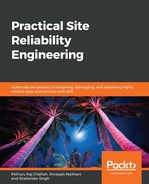As discussed previously, the software engineering field is going through a number of disruptions and transformations to cope with the growth being achieved in hardware engineering. There are agile, aspect, agent, composition, service-oriented, polyglot, and adaptive programming styles. At the time of writing this book, building reactive and cognitive applications by leveraging competent development frameworks is being stepped up. On the infrastructure side, we have powerful cloud environments as the one-stop IT solution for hosting and running business workloads. Still, there are a number of crucial challenges in achieving the much-wanted cloud operations with less intervention, interpretation, and involvement from human administrators. Already, there are several tasks getting automated via breakthrough algorithms and tools. Still, there are gaps to be filled with technologically powerful solutions. These well-known and widely used tasks include dynamic and automated capacity planning and management, cloud infrastructure provisioning and resource allocation, software deployment and configuration, patching, infrastructure and software monitoring, measurement and management, and so on. Furthermore, these days, software packages are being frequently updated, patched, and released to a production environment to meet emerging and evolving demands of clients, customers, and consumers. Also, the number of application components (microservices) is growing rapidly. In short, the true IT agility has to be ensured through a whole bunch of automated tools. The operational team with the undivided support of SREs has to envision and safeguard highly optimized and organized IT infrastructures to successfully and sagaciously host and run next-generation software applications. Precisely speaking, the brewing challenge is to automate and orchestrate cloud operations. The cloud has to be self-servicing, self-configuring, self-healing, self-diagnosing, self-defending, and self-governing to be autonomic clouds.
The new and emerging SRE domain is being prescribed as the viable way forward. A new breed of software engineers, who have a special liking of system engineering, are being touted as the best fit to be categorized as SREs. These specially skilled engineers are going to train software developers and system administrators to astutely realize highly competent and dependable software solutions, scripts, and automated tools to speedily setup and sustain highly dependable, dynamic, responsive, and programmable IT infrastructures. An SRE team literally cares about anything that makes complex software systems work in production in a risk-free and continuous manner. In short, a site reliability engineer is a hybrid software and system engineer. Due to the ubiquity and usability of cloud centers for meeting the world's IT needs, the word site represents cloud environments.
Site Reliability Engineers usually care about infrastructure orchestration, automated software deployment, proper monitoring and alerting, scalability and capacity estimation, release procedures, disaster preparedness, fail-over and fail-back capabilities, performance engineering and enhancement (PE2), garbage collector tuning, release automation, capacity uplifts, and so on. They will usually also take an interest in good test coverage. SREs are software engineers who specialize in reliability. SREs are expected to apply the proven and promising principles of computer science and engineering to the design and development of enterprise-class, modular, web-scale, and software applications.
